Spring 2020 Atmospheric Aerosol Contamination over Kyiv City
Abstract
:1. Introduction
2. Materials and Methods
2.1. In Situ Data
2.2. AERONET Sun-Photometer Data
2.3. Satellite Data on Fire Locations
2.4. Back-Trajectories Simulation Technique
3. Results and Discussion
3.1. Fire Locations
3.2. In Situ Measurements
3.3. AOD and Ångström Exponent Data of the Kyiv AERONET Site
3.4. Air Mass Back-Trajectories
3.5. Aerosol Size Distribution, Single-Scattering Albedo, and Refractive Index
4. Conclusions
Author Contributions
Funding
Institutional Review Board Statement
Informed Consent Statement
Data Availability Statement
Acknowledgments
Conflicts of Interest
References
- IPCC. Contribution of Working Group II to the Sixth Assessment Report of the Intergovernmental Panel on Climate Change. In Climate Change 2022: Impacts, Adaptation, and Vulnerability; Pörtner, H.-O., Roberts, D.C., Tignor, M., Poloczanska, E.S., Mintenbeck, K., Alegría, A., Craig, M., Langsdorf, S., Löschke, S., Möller, V., et al., Eds.; Cambridge University Press: Cambridge, UK, 2022; Available online: https://www.ipcc.ch/report/ar6/wg2/ (accessed on 20 March 2022).
- Konovalov, I.B.; Beekmann, M.; Kuznetsova, I.N.; Yurova, A.; Zvyagintsev, A.M. Atmospheric impacts of the 2010 Russian wildfires: Integrating modelling and measurements of an extreme air pollution episode in the Moscow region. Atmos. Chem. Phys. 2011, 11, 10031–10056. [Google Scholar] [CrossRef] [Green Version]
- Chubarova, N.; Nezval’, Y.; Sviridenkov, I.; Smirnov, A.; Slutsker, I. Smoke aerosol and its radiative effects during extreme fire event over Central Russia in summer 2010. Atmos. Meas. Tech. 2012, 5, 557–568. [Google Scholar] [CrossRef] [Green Version]
- Portin, H.; Mielonen, T.; Leskinen, A.; Arola, A.; Pärjälä, E.; Romakkaniemi, S.; Laaksonen, A.; Lehtinen, K.E.J.; Komppula, M. Biomass burning aerosols observed in Eastern Finland during the Russian wildfires in summer 2010-Part 1: In-situ aerosol characterization. Atmos. Environ. 2012, 47, 269–278. [Google Scholar] [CrossRef]
- Mielonen, T.; Portin, H.; Komppula, M.; Leskinen, A.; Tamminen, J.; Ialongoc, I.; Hakkarainen, J.; Lehtinen, K.E.J.; Arola, A. Biomass burning aerosols observed in Eastern Finland during the Russian wildfires in summer 2010-Part 2: Remote Sensing. Atmos. Environ. 2012, 47, 279–287. [Google Scholar] [CrossRef]
- Galytska, E.; Danylevsky, V.; Hommel, R.; Burrows, J.P. Increased aerosols content in the atmosphere over Ukraine during summer 2010. Atmos. Meas. Tech. 2018, 11, 2101–2118. [Google Scholar] [CrossRef] [Green Version]
- Markowicz, K.M.; Chilinski, M.T.; Lisok, J.; Zawadzka, O.; Stachlewska, I.S.; Janicka, L.; Rozwadowska, A.; Makuch, P.; Pakszys, P.; Zielinski, T.; et al. Study of aerosol optical properties during long-range transport of biomass burning from Canada to Central Europe in July 2013. J. Aerosol Sci. 2016, 101, 156–173. [Google Scholar] [CrossRef]
- Reid, J.S.; Koppmann, R.; Eck, T.F.; Eleuterio, D.P. A review of biomass burning emissions part II: Intensive physical properties of biomass burning particles. Atmos. Chem. Phys. 2005, 5, 799–825. [Google Scholar] [CrossRef] [Green Version]
- Putaud, J.-P.; Van Dingenen, R.; Alastuey, A.; Bauer, H.; Birmili, W.; Cyrys, J.; Flentje, H.; Fuzzi, S.; Gehrig, R.; Hansson, H.C.; et al. A European aerosol phenomenology-3: Physical and chemical characteristics of particulate matter from 60 rural, urban, and kerbside sites across Europe. Atmos. Environ. 2010, 44, 1308–1320. [Google Scholar] [CrossRef]
- Reid, J.S.; Eck, T.F.; Christopher, S.A.; Koppmann, R.; Dubovik, O.; Eleuterio, D.P.; Holben, B.N.; Reid, E.A.; Zhang, J. A review of biomass burning emissions part III: Intensive optical properties of biomass burning particles. Atmos. Chem. Phys. 2005, 5, 827–849. [Google Scholar] [CrossRef] [Green Version]
- Sayer, A.M.; Hsu, N.C.; Eck, T.F.; Smirnov, A.; Holben, B.N. AERONET-based models of smoke-dominated aerosol near source regions and transported over oceans, and implications for satellite retrievals of aerosol optical depth. Atmos. Chem. Phys. 2014, 14, 11493–11523. [Google Scholar] [CrossRef] [Green Version]
- Konovalov, I.B.; Golovushkin, N.A.; Beekmann, M.; Andreae, M.O. Insights into the aging of biomass burning aerosol from satellite observations and 3D atmospheric modeling: Evolution of the aerosol optical properties in Siberian wildfire plumes. Atmos. Chem. Phys. 2021, 21, 357–392. [Google Scholar] [CrossRef]
- Janhäll, S.; Andreae, M.O.; Pöschl, U. Biomass burning aerosol emissions from vegetation fires: Particle number and mass emission factors and size distributions. Atmos. Chem. Phys. 2010, 10, 1427–1439. Available online: https://acp.copernicus.org/articles/10/1427/2010/ (accessed on 12 January 2022). [CrossRef] [Green Version]
- Levin, E.J.T.; McMeeking, G.R.; Carrico, C.M.; Mack, L.E.; Kreidenweis, S.M.; Wold, C.E.; Moosmüller, H.; Arnott, W.P.; Hao, M.W.; Collett, J.L., Jr.; et al. Biomass burning smoke aerosol properties measured during Fire Laboratory at Missoula Experiments (FLAME). J. Geophys. Res. 2010, 115, D18210. [Google Scholar] [CrossRef]
- Kim, J.; Bauer, H.; Dobovičnik, T.; Hitzenberger, R.; Lottin, D.; Ferry, D.; Petzold, A. Assessing Optical Properties and Refractive Index of Combustion Aerosol Particles Through Combined Experimental and Modeling Studies. Aerosol Sci. Technol. 2015, 49, 340–350. [Google Scholar] [CrossRef]
- Shelestov, A.; Kolotii, A.; Borisova, T.; Turos, O.; Milinevsky, G.; Gomilko, I.; Bulanay, T.; Fedorov, O.; Shumilo, L.; Pidgorodetska, L.; et al. Essential variables for air quality estimation. Intern. J. Digital Earth 2020, 13, 278–298. [Google Scholar] [CrossRef]
- Haënninen, O.O.; Salonen, R.O.; Koistinen, K.; Lanki, T.; Barregard, L.; Jantunen, M. Population exposure to fine particles and estimated excess mortality in Finland from an East European wildfire episode. J. Expo. Sci. Environ. Epidemiol. 2009, 19, 414–422. [Google Scholar] [CrossRef] [Green Version]
- Lanzinger, S.; Schneider, A.; Breitner, S.; Stafoggia, M.; Erzenc, I.; Dostal, M.; Pastorkova, A.; Bastian, S.; Cyrys, J.; Zscheppang, A.; et al. Associations between ultrafine and fine particles and mortality in five central European cities-Results from the UFIREG study. Environ. Int. 2016, 88, 44–52. [Google Scholar] [CrossRef]
- Amaral, S.S.; de Carvalho, J.A., Jr.; Martins Costa, M.A.; Pinheiro, C. An Overview of Particulate Matter Measurement Instruments. Atmosphere 2015, 6, 1327–1345. [Google Scholar] [CrossRef] [Green Version]
- Huang, K.; Xiao, Q.; Meng, X.; Geng, G.; Wang, Y.; Lyapustin, A.; Gu, D.; Liu, Y. Predicting monthly high-resolution PM2.5 concentrations with random forest model in the North China Plain. Environ. Pollut. 2018, 242, 675–683. [Google Scholar] [CrossRef]
- Samek, L.; Turek-Fijak, A.; Skiba, A.; Furman, P.; Styszko, K.; Furman, L.; Stegowski, Z. Complex characterization of fine fraction and source contribution to PM2.5 mass at an urban area in Central Europe. Atmosphere 2020, 11, 1085. [Google Scholar] [CrossRef]
- Abera, A.; Mattisson, K.; Eriksson, A.; Ahlberg, E.; Sahilu, G.; Mengistie, B.; Bayih, A.G.; Aseffaa, A.; Malmqvist, E.; Isaxon, C. Air pollution measurements and land-use regression in urban Sub-Saharan Africa using low-cost sensors—Possibilities and pitfalls. Atmosphere 2020, 11, 1357. [Google Scholar] [CrossRef]
- Fattoruso, G.; Nocerino, M.; Toscano, D.; Pariota, L.; Sorrentino, G.; Manna, V.; De Vito, S.; Cartenì, A.; Fabbricino, M.; Di Francia, G. Site suitability analysis for low cost sensor networks for urban spatially dense air pollution monitoring. Atmosphere 2020, 11, 1215. [Google Scholar] [CrossRef]
- Schaap, M.; Apituley, A.; Timmermans, R.M.A.; Koelemeijer, R.B.A.; de Leeuw, G. Exploring the relation between aerosol optical depth and PM2.5 at Cabauw, the Netherlands. Atmos. Chem. Phys. 2009, 9, 909–925. [Google Scholar] [CrossRef] [Green Version]
- Van Donkelaar, A.; Martin, R.V.; Levy, R.C.; da Silva, A.M.; Krzyzanowski, M.; Chubarova, N.E.; Semutnikova, E.; Cohen, A.J. Satellite-based estimates of ground-level fine particulate matter during extreme events: A case study of the Moscow fires in 2010. Atmos. Environ. 2011, 45, 6225–6232. [Google Scholar] [CrossRef]
- Bovchaliuk, A. The spatial variability of PM2.5 over Europe using satellite POLDER-3/PARASOL data. Adv. Astron. Space Phys. 2013, 3, 102–108. Available online: http://aasp.kiev.ua/volume3/102-108-BovchaliukA.pdf (accessed on 12 January 2022).
- Gao, C.; Zhang, X.; Wang, W.; Xiu, A.; Tong, D.Q.; Chen, W. Spatiotemporal distribution of satellite-retrieved ground-level PM2.5 and near real-time daily retrieval algorithm development in Sichuan Basin, China. Atmosphere 2018, 9, 78. [Google Scholar] [CrossRef] [Green Version]
- Chu, Y.; Liu, Y.; Li, X.; Liu, Z.; Lu, H.; Lu, Y.; Mao, Z.; Chen, X.; Li, N.; Ren, M.; et al. A Review on Predicting Ground PM2.5 Concentration Using Satellite Aerosol Optical Depth. Atmosphere 2016, 7, 129. [Google Scholar] [CrossRef] [Green Version]
- Lennartson, E.M.; Wang, J.; Gu, J.; Garcia, L.C.; Ge, C.; Gao, M.; Choi, M.; Saide, P.E.; Carmichael, G.R.; Kim, J.; et al. Diurnal variation of aerosol optical depth and PM2:5 in South Korea: A synthesis from AERONET, satellite (GOCI), KORUS-AQ observation, and the WRF-Chem model. Atmos. Chem. Phys. 2018, 18, 15125–15144. [Google Scholar] [CrossRef] [Green Version]
- Yang, S.H.; Jeong, J.I.; Park, R.J.; Kim, M.J. Impact of Meteorological Changes on Particulate Matter and Aerosol Optical Depth in Seoul during the Months of June over Recent Decades. Atmosphere 2020, 11, 1282. [Google Scholar] [CrossRef]
- Zhao, F.; Liu, Y.; Shu, L.; Zhang, Q. Wildfire Smoke Transport and Air Quality Impacts in Different Regions of China. Atmosphere 2020, 11, 941. [Google Scholar] [CrossRef]
- Evangeliou, N.Y.; Balkanski, Y.; Cozic, A.; Hao, W.M.; Mouillot, F.; Thonicke, K.; Paugam, R.; Zibtsev, S.; Mousseau, T.A.; Wang, R.; et al. Fire evolution in the radioactive forests of Ukraine and Belarus: Future risks for the population and the environment. Ecol. Monogr. 2015, 85, 49–72. [Google Scholar] [CrossRef]
- Milinevsky, G.; Danylevsky, V.; Bovchaliuk, V.; Bovchaliuk, A.; Goloub, P.; Dubovik, O.; Kabashnikov, V.; Chaikovsky, A.; Miatselskaya, N.; Mishchenko, M.; et al. Aerosol seasonal variations over urban–industrial regions in Ukraine according to AERONET and POLDER measurements. Atmos. Meas. Tech. 2014, 7, 1459–1474. [Google Scholar] [CrossRef] [Green Version]
- Bovchaliuk, A.; Milinevsky, G.; Danylevsky, V.; Goloub, P.; Dubovik, O.; Holdak, A.; Ducos, F.; Sosonkin, M. Variability of aerosol properties over Eastern Europe observed from ground and satellites in the period from 2003 to 2011. Atmos. Chem. Phys. 2013, 13, 6587–6602. [Google Scholar] [CrossRef] [Green Version]
- Kabashnikov, V.; Milinevsky, G.; Chaikovsky, A.; Miatselskaya, N.; Danylevsky, V.; Aculinin, A.; Kalinskaya, D.; Korchemkina, E.; Bovchaliuk, A.; Pietruczuk, A.; et al. Localization of aerosol sources in East-European region by back-trajectory statistics. Int. J. Remote Sens. 2014, 35, 6993–7006. [Google Scholar] [CrossRef]
- Miatselskaya, N.; Kabashnikov, V.; Milinevsky, G.; Chaikovsky, A.; Danylevsky, V.; Bovchaliuk, V. Atmospheric aerosol distribution in the Belarus-Ukraine region by the GEOS–Chem model and AERONET measurements. Int. J. Remote Sens. 2016, 37, 3181–3195. [Google Scholar] [CrossRef]
- Miatselskaya, N.S.; Kabashnikov, V.P.; Norka, H.V.; Chaikovsky, A.P.; Bril, A.I.; Milinevsky, G.P.; Danylevsky, V.O. Atmosphere aerosol modeling by GEOS-Chem for the AEROSOL-UA space project validation. Space Sci. Technol. 2017, 23, 3–10. [Google Scholar] [CrossRef]
- Bovchaliuk, V.P.; Milinevsky, G.P.; Danylevsky, V.O.; Golub, P.; Sosonkin, M.G.; Yukhimchuk, Y.; Podvin, T. Properties of aerosol in the atmosphere over Kiev by lidar and photometric observations. Space Sci. Technol. 2017, 23, 37–47. Available online: http://knit.mao.kiev.ua/en/archive/2017/6/05 (accessed on 12 January 2022).
- Holben, B.N.; Eck, T.F.; Slutsker, I.; Tanré, D.; Buis, J.P.; Setzer, A.; Vermote, E.; Reagan, J.A.; Kaufman, Y.J.; Nakajima, T.; et al. AERONET-A Federated Instrument Network and Data Archive for Aerosol Characterization. Remote Sens. Environ. 1998, 66, 1–16. [Google Scholar] [CrossRef]
- Holben, B.N.; Kim, J.; Sano, I.; Mukai, S.; Eck, T.F.; Giles, D.M.; Schafer, J.S.; Sinyuk, A.; Slutsker, I.; Smirnov, A.; et al. An overview of mesoscale aerosol processes, comparisons, and validation studies from DRAGON networks. Atmos. Chem. Phys. 2018, 18, 655–671. [Google Scholar] [CrossRef] [Green Version]
- Draxler, R.R.; Hess, G.D. An overview of the HYSPLIT 4 modeling system for trajectories, dispersion, and deposition. Aust. Meteor. Mag. 1997, 47, 295–308. [Google Scholar]
- Stein, A.F.; Draxler, R.R.; Rolph, G.D.; Stunder, B.J.B.; Cohen, M.D.; Ngan, F. NOAA’s HYSPLIT atmospheric transport and dispersion modeling system. Bull. Amer. Meteor. Soc. 2015, 96, 2059–2077. [Google Scholar] [CrossRef]
- ZoomEarth: NOAA/NESDIS/STAR, EUMETSAT, JMA/NOAA/CIRA Global Weather Satellite Images. Available online: https://zoom.earth/ (accessed on 15 July 2021).
- FIRMS: Fire Information for Resource Management System of NASA’s Earth Observing System Data and Information System (EOSDIS). Available online: https://earthdata.nasa.gov/firms (accessed on 15 December 2021).
- IQAir AirVisual Series. Available online: https://www.iqair.com/air-quality-monitors/airvisual-pro (accessed on 15 December 2021).
- IQAir Air Quality in the World. Available online: https://airvisual.com/world (accessed on 15 December 2021).
- Dubovik, O.; King, M.D. A flexible inversion algorithm for retrieval of aerosol optical properties from Sun and sky radiance measurements. J. Geophys. Res. 2000, 105, 20673–20696. [Google Scholar] [CrossRef] [Green Version]
- Sinyuk, A.; Holben, B.N.; Eck, T.F.; Giles, D.M.; Slutsker, I.; Korkin, S.; Schafer, J.S.; Smirnov, A.; Sorokin, M.; Lyapustin, A. The AERONET Version 3 aerosol retrieval algorithm, associated uncertainties and comparisons to Version 2. Atmos. Meas. Tech. 2020, 13, 3375–3411. [Google Scholar] [CrossRef]
- Giles, D.M.; Sinyuk, A.; Sorokin, M.G.; Schafer, J.S.; Smirnov, A.; Slutsker, I.; Eck, T.F.; Holben, B.N.; Lewis, J.R.; Campbell, J.R.; et al. Advancements in the Aerosol Robotic Network (AERONET) Version 3 database-automated near-real-time quality control algorithm with improved cloud screening for Sun photometer aerosol optical depth (AOD) measurements. Atmos. Meas. Tech. 2019, 12, 169–209. [Google Scholar] [CrossRef] [Green Version]
- Milinevsky, G.; Danylevsky, V. Atmospheric aerosol over Ukraine region: Current status of knowledge and research efforts. Front. Environ. Sci. 2018, 6, 59. [Google Scholar] [CrossRef]
- Kyiv AERONET Site: AERONET Aerosol Robotic Network, Site Information Database. Available online: https://aeronet.gsfc.nasa.gov/new_web/photo_db_v3/Kyiv.html (accessed on 15 December 2021).
- Boucher, O. Properties and climate Impacts. In Atmospheric Aerosols; Springer: Dordrecht, The Netherlands, 2015; p. 311. [Google Scholar] [CrossRef]
- O’Neill, N.T.; Eck, T.F.; Smirnov, A.; Holben, B.N.; Thulasiraman, S. Spectral discrimination of coarse and fine mode optical depth. J. Geophys. Res. 2003, 108, 4559–4573. [Google Scholar] [CrossRef]
- Stohl, A. Computation, accuracy and applications of trajectories: A review and bibliography. Atmos. Environ. 1998, 32, 947–966. [Google Scholar] [CrossRef]
- AERONET/Data Synergy Tool. Available online: https://aeronet.gsfc.nasa.gov/cgi-bin/bamgomas_interactive (accessed on 20 March 2022).
- Sapkota, A.; Symons, J.M.; Kleissl, J.; Wang, L.; Parlange, M.B.; Ondov, J.; Breysse, P.N.; Diette, G.B.; Eggleston, P.A.; Buckley, T.J. Impact of the 2002 Canadian forest fires on particulate matter air quality in Baltimore city. Environ. Sci. Technol. 2005, 39, 24–32. [Google Scholar] [CrossRef] [PubMed] [Green Version]
- HYSPLIT Website Service, NOAA Air Resources Laboratory. Available online: https://www.ready.noaa.gov/HYSPLIT.php (accessed on 18 March 2022).
- Alados-Arboledas, L.; Müller, D.; Guerrero-Rascado, J.L.; Navas-Guzmán, F.; Pérez-Ramírez, D.; Olmo, F.J. Optical and microphysical properties of fresh biomass burning aerosol retrieved by Raman lidar, and star- and sun-photometry. Geophys. Res. Lett. 2011, 38, L01807. [Google Scholar] [CrossRef]
- NAAPS: Navy Aerosol Analysis and Prediction System. Naval Research Lab Monterey ICAP Multi-Model Ensemble. Available online: https://www.nrlmry.navy.mil/aerosol_web/Docs/nrlmryonrprop.html (accessed on 7 April 2022).
- Dubovik, O.; Holben, B.; Eck, T.F.; Smirnov, A.; Kaufman, Y.J.; King, M.D.; Tanré, D.; Slutsker, I. Variability of absorption and optical properties of key aerosol types observed in worldwide locations. J. Atmos. Sci. 2002, 59, 590–608. [Google Scholar] [CrossRef]
- Mousseau, T.A. The biology of Chernobyl. Annu. Rev. Ecol. Evol. Syst. 2021, 52, 87–109. [Google Scholar] [CrossRef]
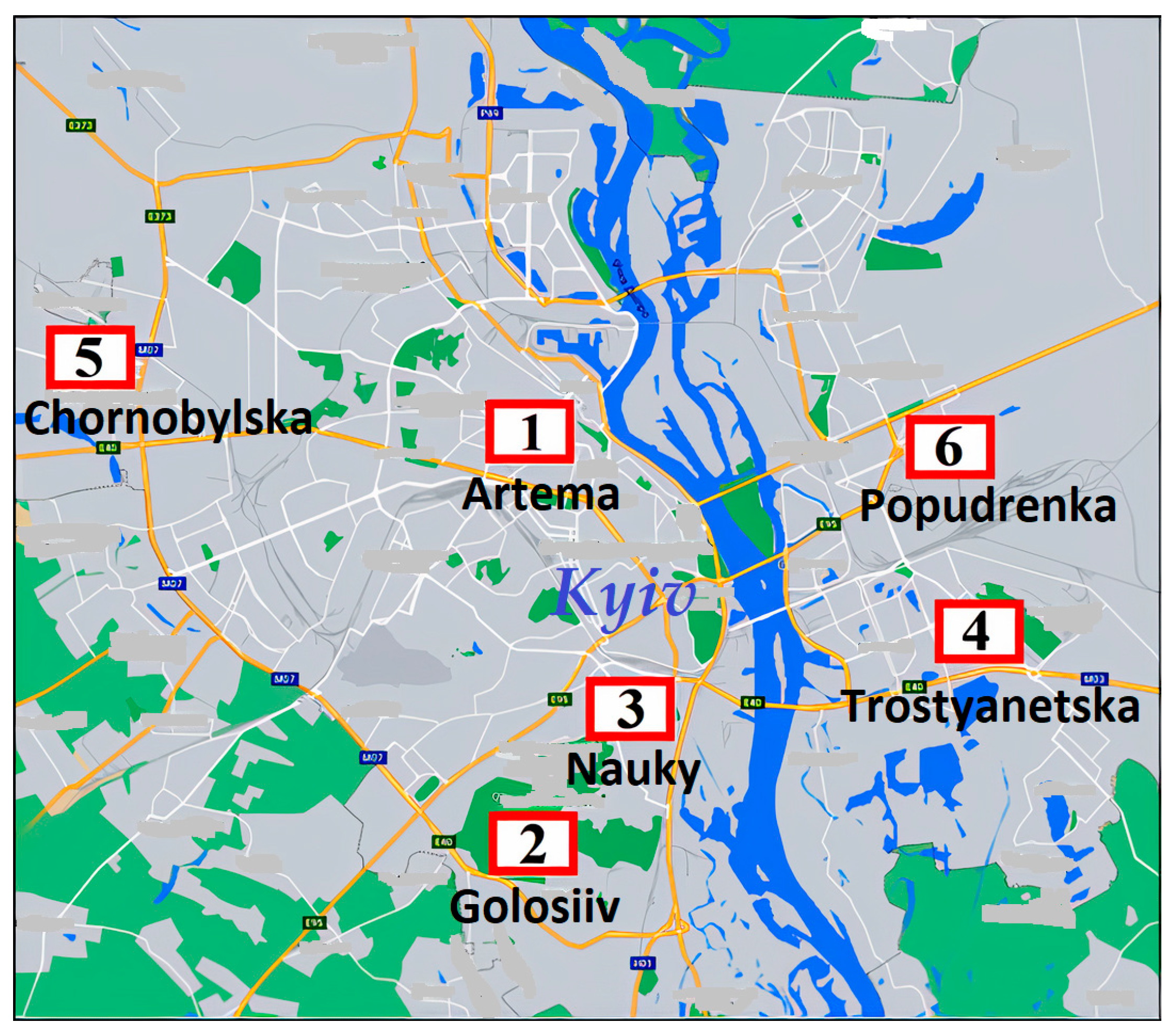
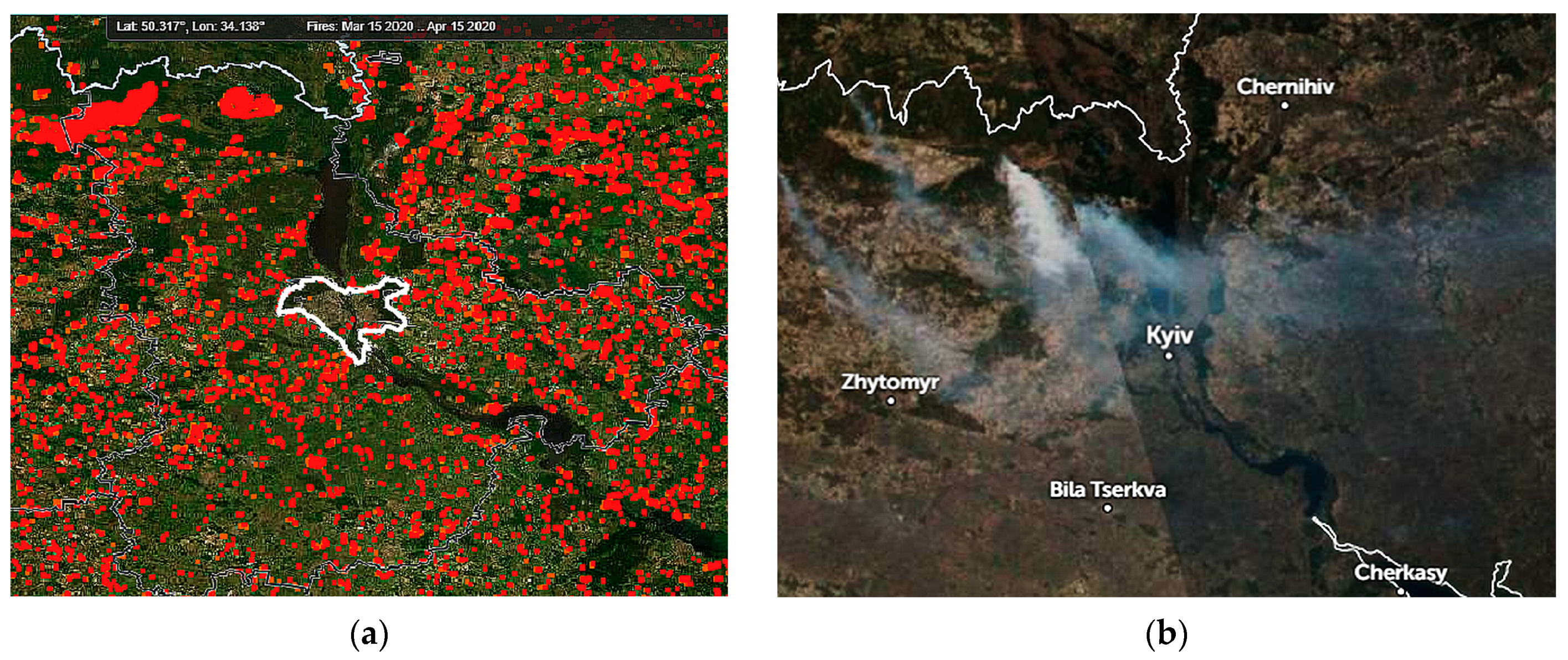
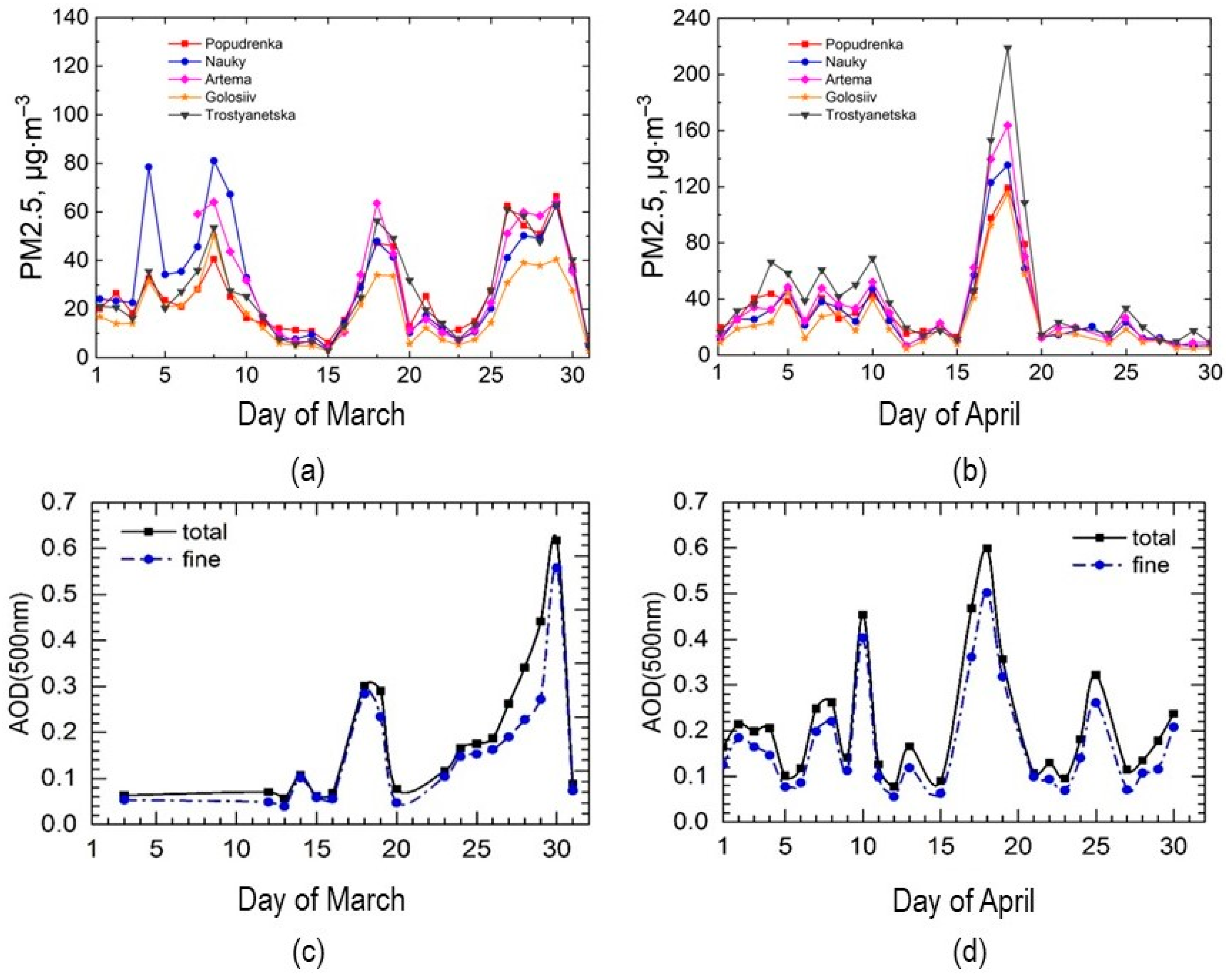

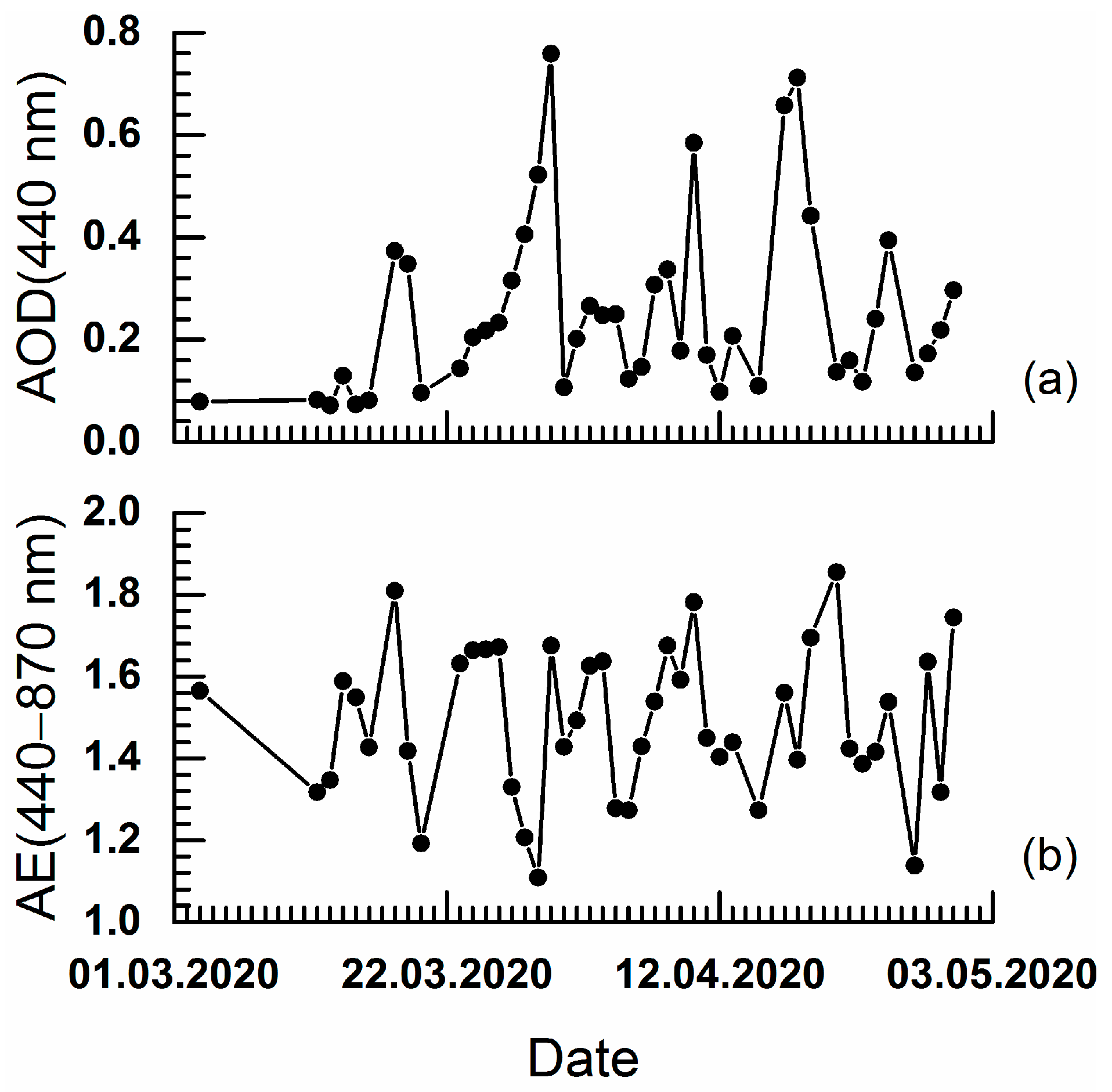
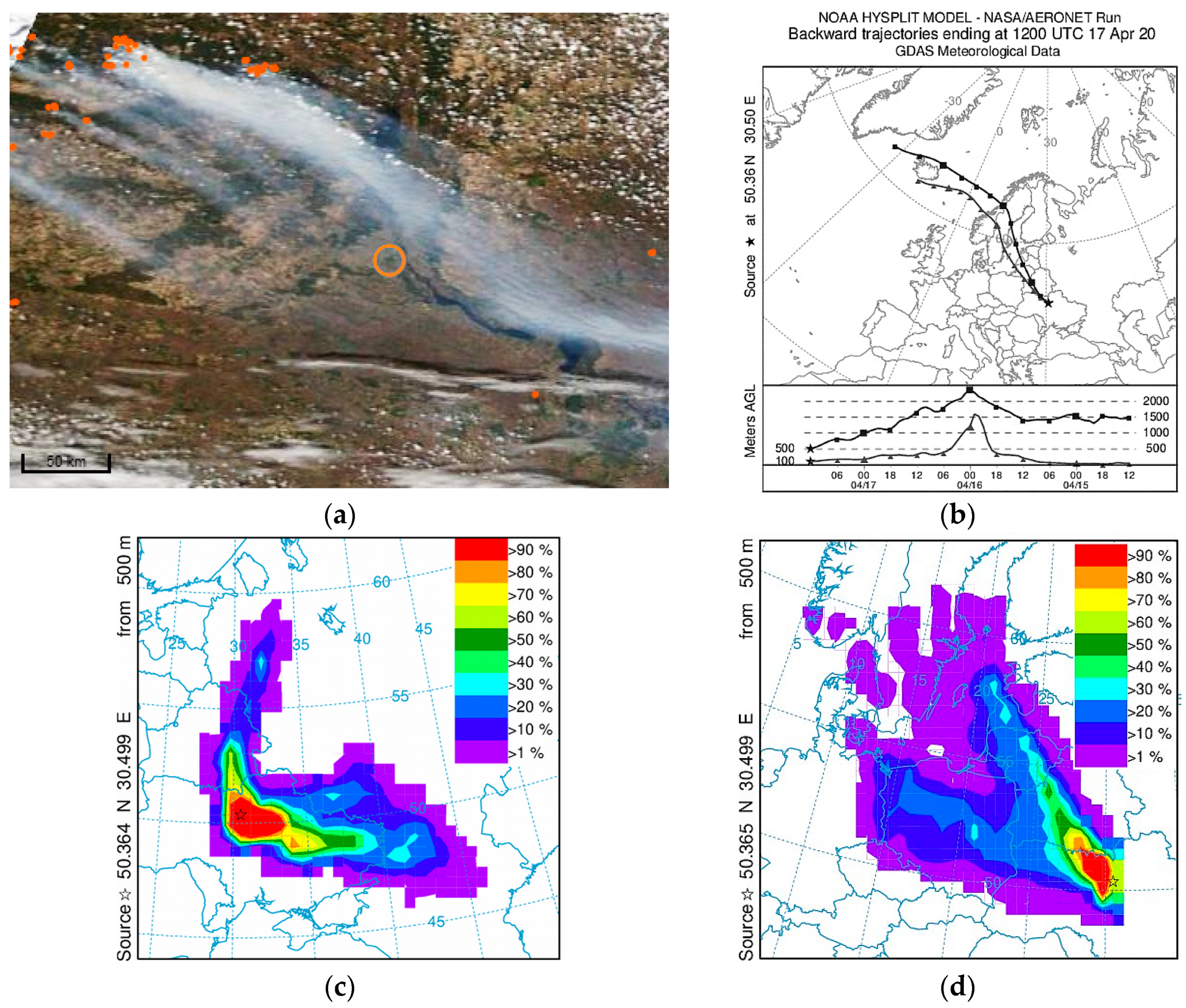
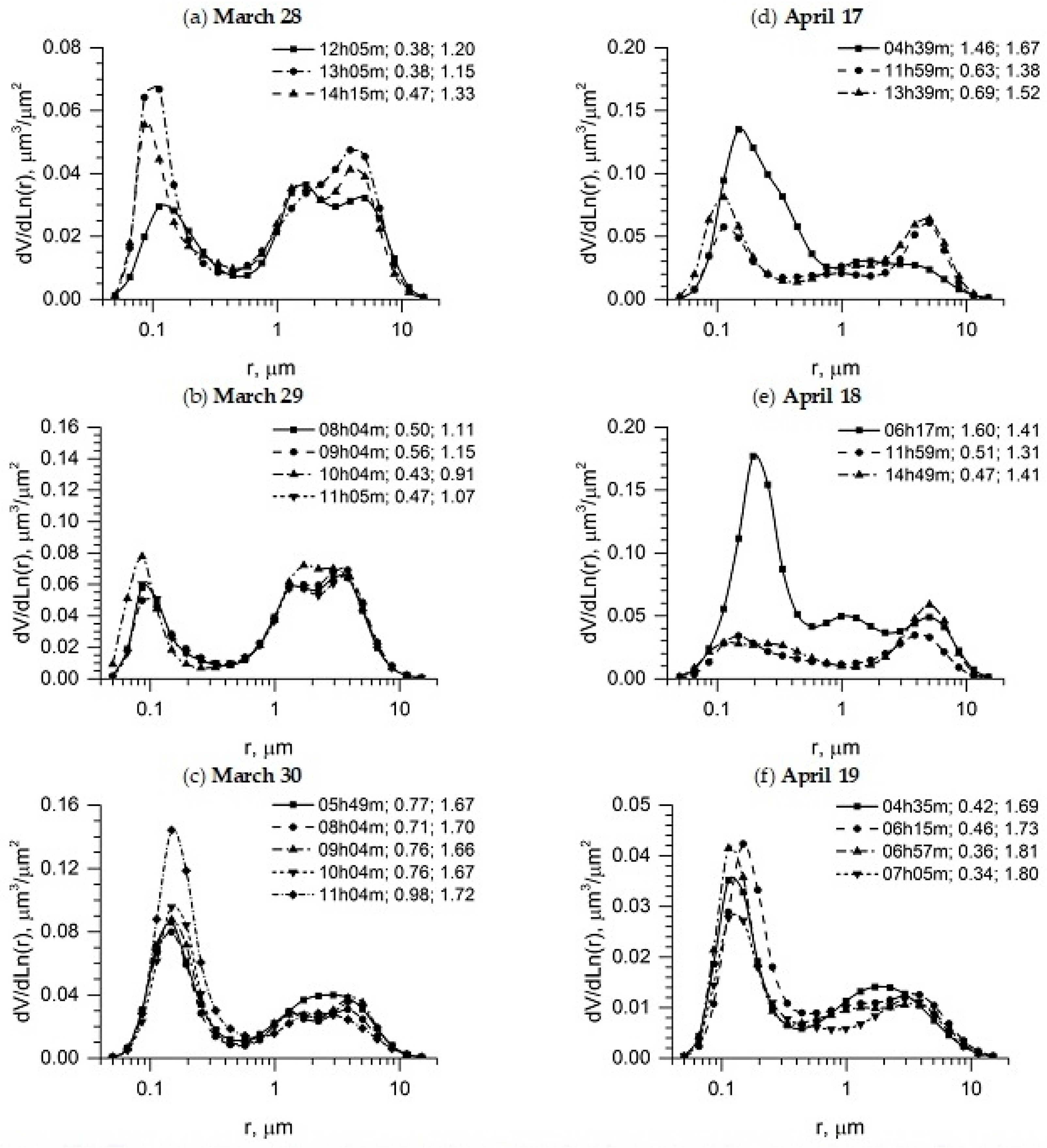
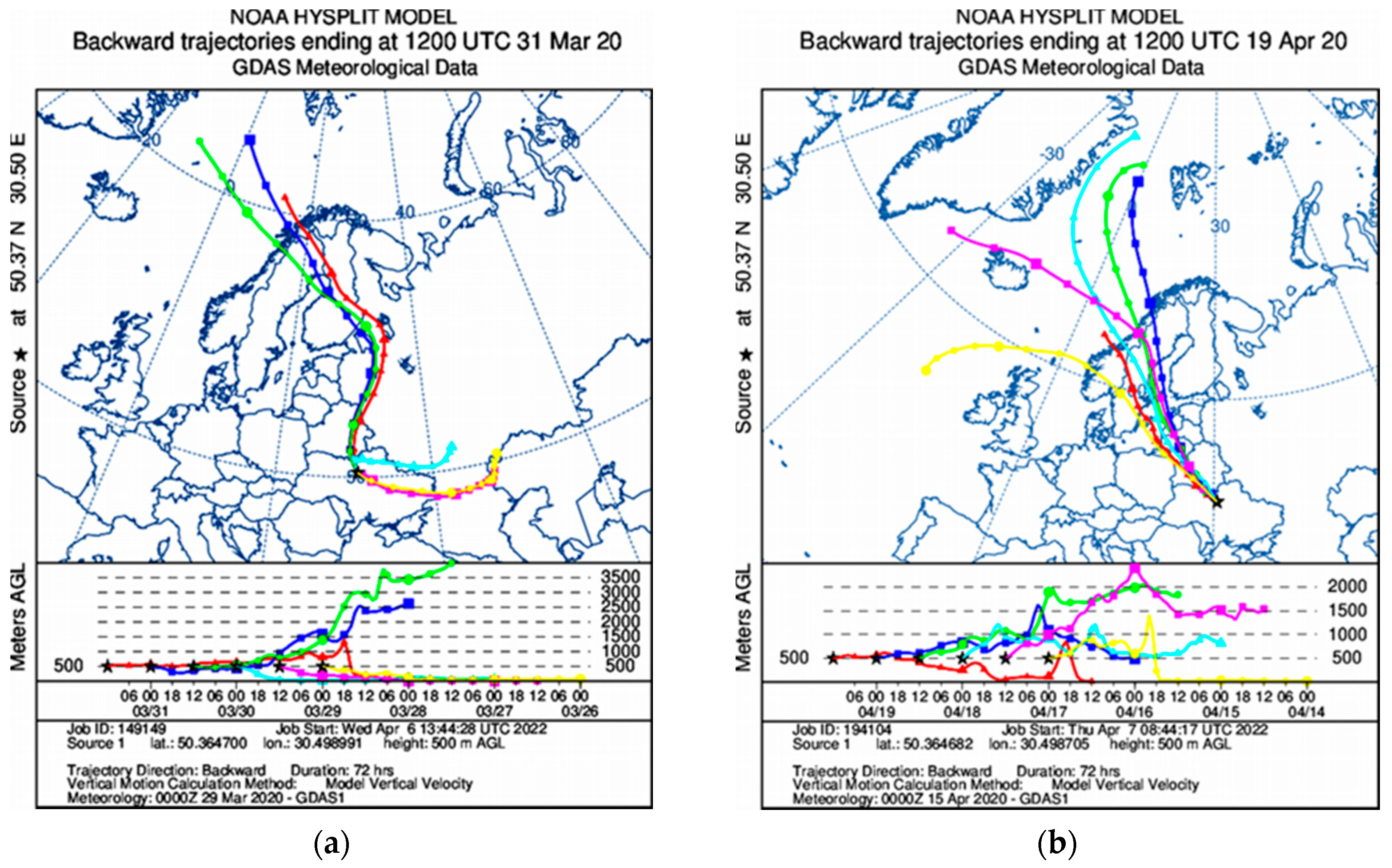
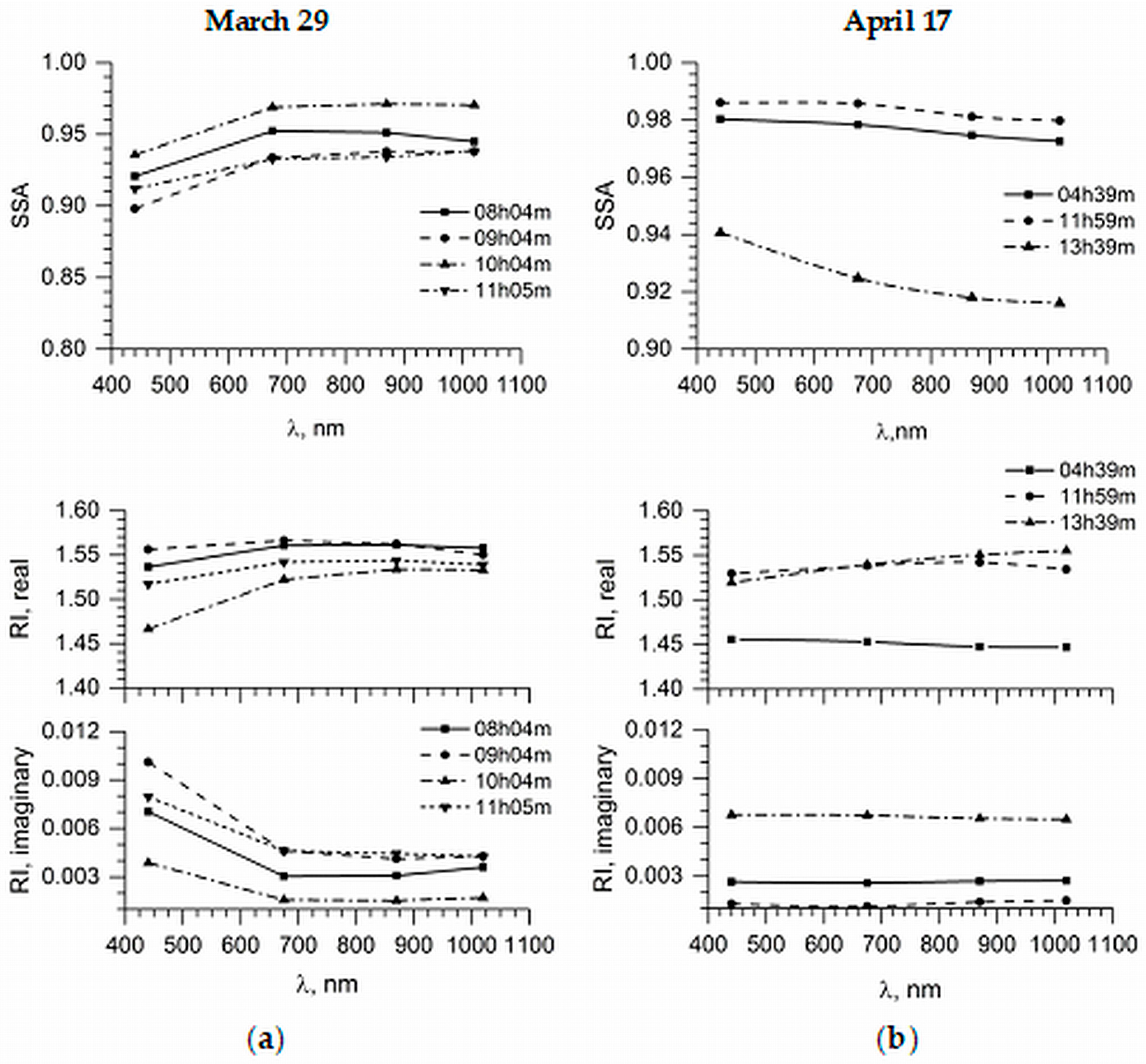
| Date | Time | Fine Mode Parameters | Coarse Mode Parameters | AOD (440 nm) | AE (440–870 nm) | ||||
|---|---|---|---|---|---|---|---|---|---|
| Reff, μm | RMed, μm | STD | Reff, μm | RMed, μm | STD | ||||
| 28 March 2020 | 12:05 | 0.133 | 0.149 | 0.479 | 1.878 | 2.486 | 0.755 | 0.38 | 1.20 |
| 28 March 2020 | 13:05 | 0.112 | 0.122 | 0.432 | 1.932 | 2.567 | 0.737 | 0.38 | 1.15 |
| 28 March 2020 | 14:15 | 0.113 | 0.126 | 0.493 | 1.800 | 2.374 | 0.740 | 0.47 | 1.33 |
| 29 March 2020 | 08:04 | 0.110 | 0.121 | 0.467 | 1.779 | 2.229 | 0.672 | 0.50 | 1.11 |
| 29 March 2020 | 09:04 | 0.114 | 0.126 | 0.484 | 1.800 | 2.271 | 0.680 | 0.56 | 1.15 |
| 29 March 2020 | 10:04 | 0.092 | 0.100 | 0.463 | 1.791 | 2.219 | 0.653 | 0.43 | 0.91 |
| 29 March 2020 | 11:05 | 0.112 | 0.124 | 0.472 | 1.773 | 2.240 | 0.682 | 0.47 | 1.07 |
| 29 March 2020 | 12:04 | 0.111 | 0.122 | 0.471 | 1.833 | 2.363 | 0.704 | 0.48 | 1.05 |
| 29 March 2020 | 13:04 | 0.113 | 0.124 | 0.467 | 1.883 | 2.409 | 0.692 | 0.56 | 1.16 |
| 29 March 2020 | 14:17 | 0.113 | 0.123 | 0.434 | 1.947 | 2.477 | 0.684 | 0.60 | 1.23 |
| 29 March 2020 | 14:59 | 0.126 | 0.135 | 0.382 | 1.906 | 2.365 | 0.653 | 0.54 | 1.16 |
| 30 March 2020 | 05:49 | 0.147 | 0.162 | 0.456 | 1.952 | 2.448 | 0.679 | 0.77 | 1.67 |
| 30 March 2020 | 08:04 | 0.143 | 0.157 | 0.439 | 1.897 | 2.399 | 0.699 | 0.71 | 1.70 |
| 30 March 2020 | 09:04 | 0.144 | 0.156 | 0.392 | 1.782 | 2.385 | 0.758 | 0.76 | 1.66 |
| 30 March 2020 | 10:04 | 0.154 | 0.168 | 0.418 | 1.984 | 2.531 | 0.704 | 0.76 | 1.67 |
| 30 March 2020 | 11:04 | 0.162 | 0.178 | 0.470 | 2.079 | 2.528 | 0.644 | 0.98 | 1.72 |
| 17 April 2020 | 04:39 | 0.187 | 0.220 | 0.601 | 2.285 | 2.745 | 0.632 | 1.46 | 1.67 |
| 17 April 2020 | 11:59 | 0.135 | 0.149 | 0.471 | 1.828 | 2.676 | 0.837 | 0.63 | 1.38 |
| 17 April 2020 | 13:39 | 0.120 | 0.132 | 0.456 | 1.939 | 2.731 | 0.798 | 0.69 | 1.52 |
| 18 April 2020 | 06:17 | 0.192 | 0.213 | 0.453 | 1.669 | 2.286 | 0.826 | 1.60 | 1.41 |
| 18 April 2020 | 11:59 | 0.184 | 0.226 | 0.683 | 2.913 | 3.446 | 0.571 | 0.51 | 1.31 |
| 18 April 2020 | 14:49 | 0.176 | 0.223 | 0.711 | 3.575 | 4.183 | 0.532 | 0.47 | 1.41 |
| 19 April 2020 | 04:35 | 0.132 | 0.143 | 0.425 | 1.451 | 1.897 | 0.754 | 0.42 | 1.69 |
| 19 April 2020 | 06:15 | 0.159 | 0.176 | 0.476 | 1.706 | 2.249 | 0.765 | 0.46 | 1.73 |
| 19 April 2020 | 06:57 | 0.130 | 0.141 | 0.420 | 1.427 | 1.966 | 0.824 | 0.36 | 1.81 |
| 19 April 2020 | 07:05 | 0.149 | 0.172 | 0.582 | 2.180 | 2.677 | 0.647 | 0.34 | 1.80 |
Publisher’s Note: MDPI stays neutral with regard to jurisdictional claims in published maps and institutional affiliations. |
© 2022 by the authors. Licensee MDPI, Basel, Switzerland. This article is an open access article distributed under the terms and conditions of the Creative Commons Attribution (CC BY) license (https://creativecommons.org/licenses/by/4.0/).
Share and Cite
Zhang, C.; Shulga, V.; Milinevsky, G.; Danylevsky, V.; Yukhymchuk, Y.; Kyslyi, V.; Syniavsky, I.; Sosonkin, M.; Goloub, P.; Turos, O.; et al. Spring 2020 Atmospheric Aerosol Contamination over Kyiv City. Atmosphere 2022, 13, 687. https://doi.org/10.3390/atmos13050687
Zhang C, Shulga V, Milinevsky G, Danylevsky V, Yukhymchuk Y, Kyslyi V, Syniavsky I, Sosonkin M, Goloub P, Turos O, et al. Spring 2020 Atmospheric Aerosol Contamination over Kyiv City. Atmosphere. 2022; 13(5):687. https://doi.org/10.3390/atmos13050687
Chicago/Turabian StyleZhang, Chenning, Valery Shulga, Gennadi Milinevsky, Vassyl Danylevsky, Yuliya Yukhymchuk, Volodymyr Kyslyi, Ivan Syniavsky, Mikhail Sosonkin, Philippe Goloub, Olena Turos, and et al. 2022. "Spring 2020 Atmospheric Aerosol Contamination over Kyiv City" Atmosphere 13, no. 5: 687. https://doi.org/10.3390/atmos13050687
APA StyleZhang, C., Shulga, V., Milinevsky, G., Danylevsky, V., Yukhymchuk, Y., Kyslyi, V., Syniavsky, I., Sosonkin, M., Goloub, P., Turos, O., Simon, A., Choliy, V., Maremukha, T., Petrosian, A., Pysanko, V., Honcharova, A., Shulga, D., Miatselskaya, N., & Morhuleva, V. (2022). Spring 2020 Atmospheric Aerosol Contamination over Kyiv City. Atmosphere, 13(5), 687. https://doi.org/10.3390/atmos13050687








